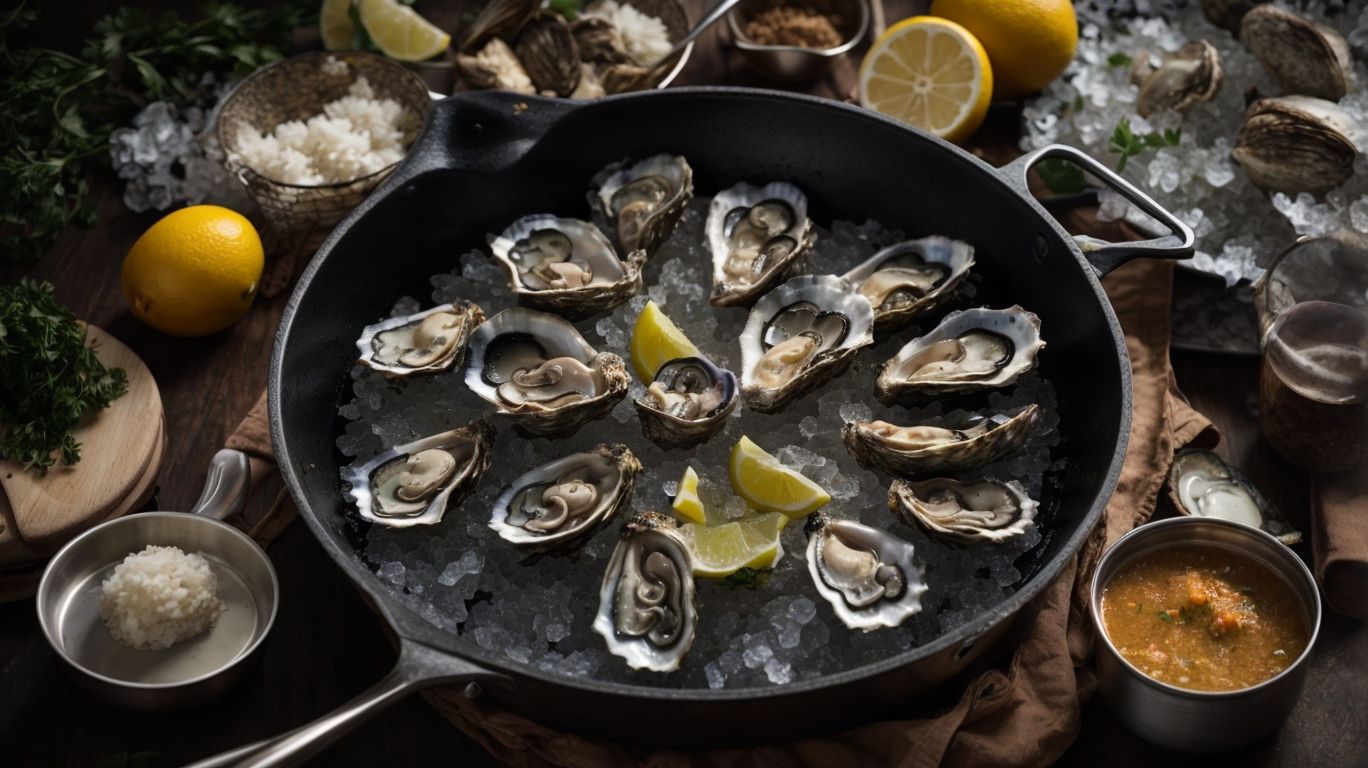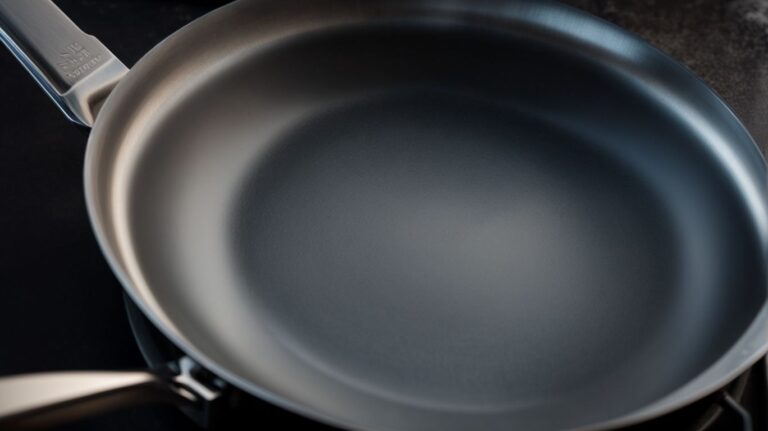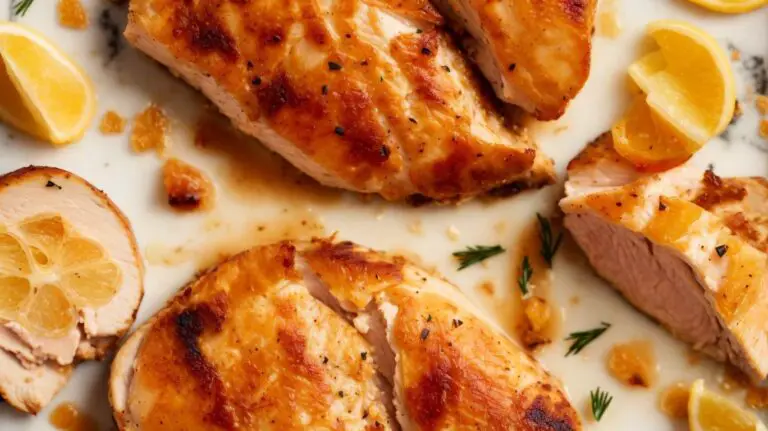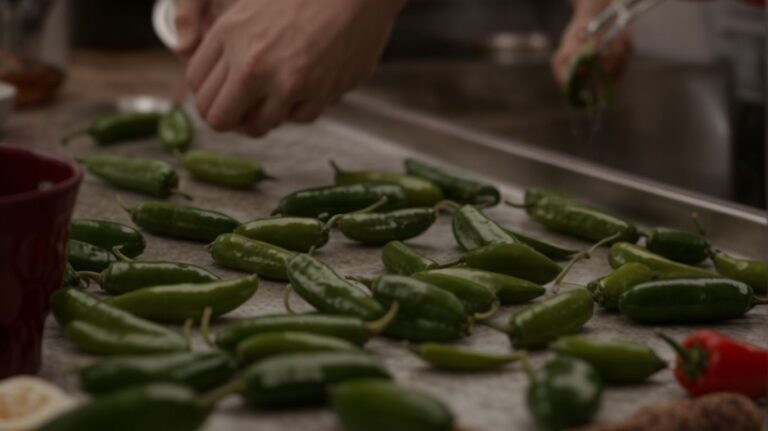How to Cook Oysters?
Love seafood, especially oysters, but not sure how to prepare them at home? This article covers everything you need to know about choosing, shucking, cleaning, storing, and cooking oysters.
Explore various cooking techniques from grilling and baking to frying and steaming to bring out the best flavors in these delectable mollusks.
Discover delicious oyster recipes like Oysters Rockefeller and Oyster Pasta to impress your guests at your next dinner party.
Stay tuned for all the culinary secrets!
Key Takeaways:
What Are Oysters?
Oysters are a type of seafood known for their unique taste and texture, often enjoyed raw or cooked in various culinary dishes.
Oysters are not only a delicious delicacy but also packed with essential nutrients such as zinc, iron, and omega-3 fatty acids. These minerals are crucial for supporting immune function, promoting heart health, and improving brain function. There are several varieties of oysters, including East Coast, West Coast, Kumamoto, and Blue Point, each offering a slightly different flavor profile and size. Oysters play a significant role in culinary culture worldwide, being a staple in dishes like Oysters Rockefeller, Oyster Po’ Boy, and classic Oysters Kilpatrick.
Where Can You Find Oysters?
Oysters can be found at local fishmongers, seafood markets, and specialty restaurants like the Main Lobster House, offering a variety of fresh options for culinary enthusiasts.
Those who appreciate the distinctive flavor and texture of fresh oysters can also explore renowned seafood establishments along the coast, where these delectable mollusks are sourced directly from the ocean. Plus fishmongers and local markets, coastal regions like New England and the Pacific Northwest are well-known for their abundance of high-quality oysters.
The belief in serving only the freshest seafood has driven establishments like the Main Lobster House to establish direct relationships with oyster farms, ensuring that their patrons experience the true essence of these briny delights. From the bustling docks of Maine to the serene bays of Washington State, the journey of oysters from seabed to plate is a testament to the dedication of seafood purveyors in providing unparalleled quality.
Choosing and Preparing Oysters
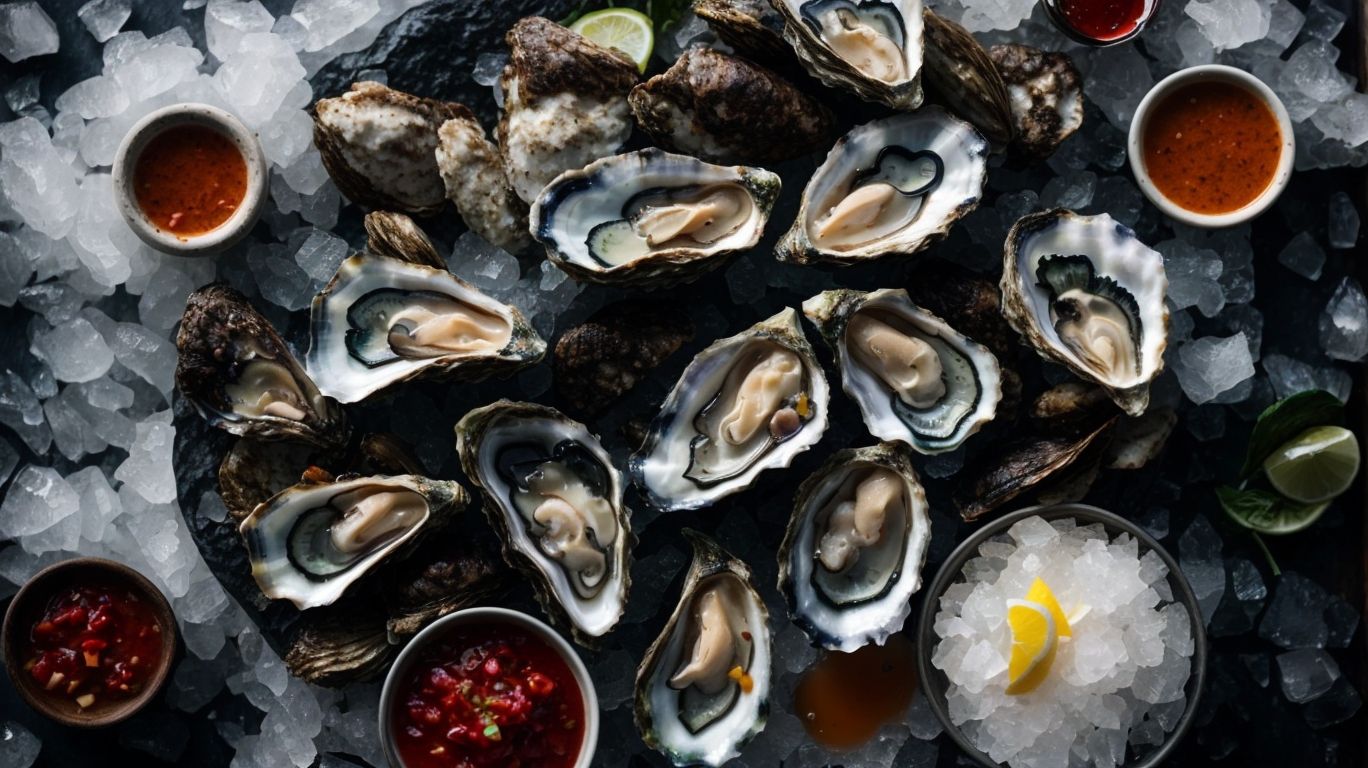
Credits: Poormet.Com – Henry Sanchez
Choosing and preparing oysters requires attention to detail and the right ingredients such as lemon, butter, and parsley to enhance their natural flavors.
How to Choose Fresh Oysters?
Selecting fresh oysters involves checking for intact shells, a briny smell of the sea, and ensuring they are tightly closed to indicate freshness and quality.
In terms of choosing top-quality oysters, the appearance of the shell plays a crucial role. Opt for shells that are clean, devoid of any cracks, and have a deep cup to hold the precious briny liquid within. The tightly closed oysters indicate that they are still alive. As for the aroma, a fresh oyster should smell like a refreshing sea breeze, not a fishy or unpleasant odor. Properly storing oysters in the refrigerator is key to maintaining their freshness – store them in a bowl with a damp cloth or seaweed to keep them moist until ready to enjoy.
How to Shuck Oysters?
Shucking oysters involves carefully opening the shells with a knife, being cautious not to spill the flavorful juices inside, and adding savory ingredients like garlic and olive oil for extra taste.
Before you begin shucking, make sure to wear a shucking glove or wrap the oyster in a kitchen towel to protect your hand from slips and potential cuts.
- To enhance the flavors, consider options like lemon zest, hot sauce, or a sprinkle of freshly ground black pepper on the oyster meat.
- Once the oyster is shucked, you can choose to enjoy it raw, grill it with a miso butter sauce, or bake it with a flavorful breadcrumb topping for a delicious treat.
Experiment with different seasoning combinations to discover your favorite way to enjoy freshly shucked oysters!
How to Clean Oysters?
Cleaning oysters involves rinsing them under cold water to remove any residual dirt or sand, ensuring they are free of impurities before preparing them in Mediterranean-inspired recipes.
After the initial rinsing, it is crucial to scrub the oysters with a brush to get rid of any stubborn debris clinging to the shells. This step not only ensures cleanliness but also aids in enhancing the presentation of the final dish.
- Next, immerse the oysters in a mixture of water and vinegar to help eliminate bacteria that might be present.
- For the final touch, shuck the oysters carefully, discarding any liquid inside before incorporating them into delectable Mediterranean dishes such as oysters Rockefeller or grilled oysters with garlic butter.
How to Store Oysters?
Storing oysters correctly is essential for maintaining their freshness and flavor, with recommendations including keeping them refrigerated and consuming Pacific oysters within a specific timeframe for optimal taste.
When storing oysters, it is crucial to store them in the refrigerator between 35-40 degrees Fahrenheit to prevent them from spoiling due to temperature fluctuations. It is advisable to place them in a mesh bag or shallow container to maintain their natural moisture levels without drowning them.
Remember to discard any oysters that have cracked or are open before cooking them, as this could indicate spoilage. Pacific oysters tend to have a shorter shelf life compared to other varieties, so it’s best to consume them within a week of purchase.
Cooking Techniques for Oysters
Mastering cooking techniques for oysters involves grilling, baking, frying, and steaming these delectable shellfish to perfection, with the added zest of lemon to elevate their flavors.
Grilling Oysters
Grilling oysters imparts a smoky flavor and enhances their natural sweetness, especially when brushed with melted butter for a rich and indulgent finish.
When grilling oysters, it’s crucial not to overcook them, as they can quickly become tough and lose their delicate texture. To achieve the perfect oyster on the grill, preheat your grill to high heat and place the oysters cup-side down. The high heat will help the oysters to open up, making them easier to shuck. Another essential step is ensuring the oysters are fresh; they should be tightly closed before grilling. For added flavor, consider incorporating toppings such as garlic, Parmesan cheese, or a squeeze of lemon before serving.
Baking Oysters
Baking oysters with a crunchy breadcrumb topping creates a delightful contrast of textures, adding a savory element to the succulent shellfish for a satisfying dining experience.
Coating the oysters in a mixture of breadcrumbs, herbs, garlic, and grated parmesan cheese enhances the flavors and creates a crispy golden crust when baked. In terms of baking methods, some prefer shucking the oysters first before placing them on a baking dish, while others opt to bake them in their shells for a more elegant presentation. Whether you choose to bake them on a bed of rock salt to keep them stable or arrange them on a baking sheet, the key is to bake them just until the breadcrumbs are golden brown and the oysters are cooked through.
Frying Oysters
Frying oysters to a golden crispness with a seasoned breadcrumb coating offers a delicious treat that showcases the shellfish’s tenderness and flavor, perfect for seafood lovers.
For those looking to master the art of frying oysters, it’s essential to start with fresh, plump oysters. After shucking the oysters, it’s time to prepare the breading. A popular technique involves first coating the oysters in seasoned flour, then dipping them in beaten eggs and finally coating them with breadcrumbs. The key here is to ensure each oyster is thoroughly coated but not overloaded with breading to allow the flavor of the shellfish to shine through.
Steaming Oysters
Steaming oysters preserves their natural juices and delicate texture, with a splash of lemon juice enhancing their briny essence for a light and refreshing culinary delight.
When steaming oysters, it’s crucial to select fresh specimens, ensuring their quality and taste. The steaming process involves placing the oysters in a steaming basket over boiling water to gently cook them without losing their rich flavors. As steam envelops the oysters, the heat gradually opens their shells, revealing the succulent meat within. Many variations of flavor infusions can be incorporated during steaming, such as herb butter, garlic, or white wine sauce, adding layers of complexity to the dish.
Raw Oysters
Raw oysters are a classic delicacy enjoyed for their fresh, briny taste, often served with a sprinkle of parsley and a squeeze of lemon to highlight their natural flavors.
What makes raw oysters so appealing is their unique texture, which is simultaneously tender and slightly chewy, providing a delightful contrast with their salty essence. Raw oysters can be presented in various styles; classic methods include serving them on a bed of ice to maintain their freshness or arranging them on a platter with seaweed for a touch of oceanic charm.
Accompaniments play a crucial role in enhancing the overall experience of consuming raw oysters. Traditional garnishes such as mignonette sauce, horseradish, and cocktail sauce are favored for their ability to complement the brininess of the oysters while adding layers of flavor.
Delicious Oyster Recipes
Indulge in a culinary adventure with delectable oyster recipes like Oysters Rockefeller, Oyster Po’ Boys, Oyster Chowder, Oyster Stew, and Oyster Pasta, each offering a unique blend of flavors and textures enhanced by ingredients such as lemon, breadcrumbs, and parsley.
Oysters Rockefeller
Oysters Rockefeller is a sumptuous dish featuring oysters topped with a rich blend of butter, parsley, and breadcrumbs, baked to perfection for a decadent dining experience.
To prepare this luxurious dish, begin by shucking fresh oysters and arranging them on a bed of rock salt in a baking dish. The topping mixture, consisting of a sublime combination of butter, spinach, shallots, a hint of anise-flavored liqueur such as Pernod, and a touch of tangy lemon juice, is then generously spooned over each oyster.
After carefully assembling the oysters with the flavorful blend, bake them in a preheated oven until the topping is golden brown and bubbly. This process usually takes about 10-15 minutes, just enough time for the oysters to cook through while remaining tender and succulent.
Oyster Po’ Boys
Oyster Po’ Boys are a Southern delicacy consisting of fried oysters nestled in a soft bun, served with a squeeze of lemon for a zesty twist on a classic comfort food dish.
The key to achieving the perfect Oyster Po’ Boy lies in the frying technique. Start by shucking fresh oysters, dipping them in a seasoned flour mixture, and then frying them until golden brown and crispy. This cooking method ensures that the oysters are juicy on the inside and crunchy on the outside.
When assembling the sandwich, spread a generous amount of remoulade sauce on the bun, layer the fried oysters on top, and top it off with shredded lettuce, sliced tomatoes, and pickles for added crunch and freshness.
To elevate the flavors further, consider adding a sprinkle of Old Bay seasoning or a dash of hot sauce to give the Oyster Po’ Boy an extra kick that complements the briny sweetness of the oysters.
Oyster Chowder
Oyster Chowder is a hearty seafood soup brimming with plump oysters, vegetables, and savory broth, offering a comforting and flavorful dish for seafood lovers.
To make a delicious Oyster Chowder, start by selecting fresh, briny oysters to ensure the best flavor. Gather ingredients such as onions, potatoes, celery, and bacon to add depth to the chowder. In a large pot, sauté the bacon until crispy, then add in the vegetables to build a flavorful base. Next, pour in fish stock or clam juice along with heavy cream, allowing the flavors to meld together over low heat.
Oyster Stew
Oyster Stew is a creamy and aromatic dish featuring tender oysters simmered in a garlic-infused broth, perfect for warming up on chilly evenings with a bowl of comfort and flavor.
To prepare the flavorful broth for this delectable stew, you can start by sautéing finely chopped onions and celery in butter until they turn translucent. Next, add in some flour to create a roux, which will help thicken the stew to a rich consistency.
For the ingredient combinations, consider adding in whole milk and a touch of heavy cream to the broth for a luscious and creamy texture. Season generously with salt, black pepper, and a pinch of cayenne pepper for that extra kick.
Once the broth has reached a gentle simmer, gently fold in the fresh oysters, being careful not to overcook them to maintain their delicate texture.
Oyster Pasta
Oyster Pasta is a Mediterranean-inspired dish that combines al dente pasta with plump oysters, garlic, and olive oil, creating a simple yet flavorful culinary experience reminiscent of coastal living.
When making Oyster Pasta, it’s crucial to choose the right type of pasta to complement the delicate flavor of the oysters. Opt for long, thin pasta shapes like linguine or spaghetti to ensure that every strand intertwines with the savory sauce.
For the sauce, heating olive oil in a pan and lightly sautéing minced garlic until fragrant is the foundation of this dish. This simple yet aromatic base pairs perfectly with the briny sweetness of the oysters, ensuring a harmonious blend of flavors.
To further enhance the Mediterranean flair of this dish, add a hint of fresh parsley and a squeeze of lemon juice just before serving, balancing the richness of the oysters and olive oil with a zesty freshness.
Frequently Asked Questions
How to Cook Oysters?
1. What are some basic methods for cooking oysters?
There are several ways to cook oysters, including grilling, frying, roasting, and steaming. Each method brings out different flavors and textures in the oysters, so it’s worth trying them out to see which one you prefer.
2. How do I know when oysters are cooked?
When cooking oysters, it’s important to pay attention to their appearance. Oysters that are cooked properly will have plump, juicy flesh and a slightly opaque appearance. Overcooked oysters will become tough and rubbery.
3. Can I cook oysters in the shell?
Yes, oysters can be cooked in their shells. However, they can also be shucked and cooked without the shell. Cooking them in the shell can help retain their natural juices and flavor, while shucked oysters are great for dishes like oyster stew or pasta.
4. How do I prepare oysters for cooking?
Oysters should be stored in a cool, damp place until you are ready to cook them. Before cooking, scrub the shells with a stiff brush to remove any dirt or debris. If shucking, be sure to remove any remaining pieces of shell.
5. Can I cook oysters from frozen?
While fresh oysters are always best, you can also cook oysters from frozen. Make sure to thaw them completely before cooking and be aware that they may lose some of their texture during the freezing process.
6. How do I know if an oyster is safe to eat?
Always purchase oysters from a reputable source and make sure they are still alive before cooking (they should be tightly closed). If any oysters have opened, discard them. Additionally, always cook oysters thoroughly to kill any harmful bacteria.

